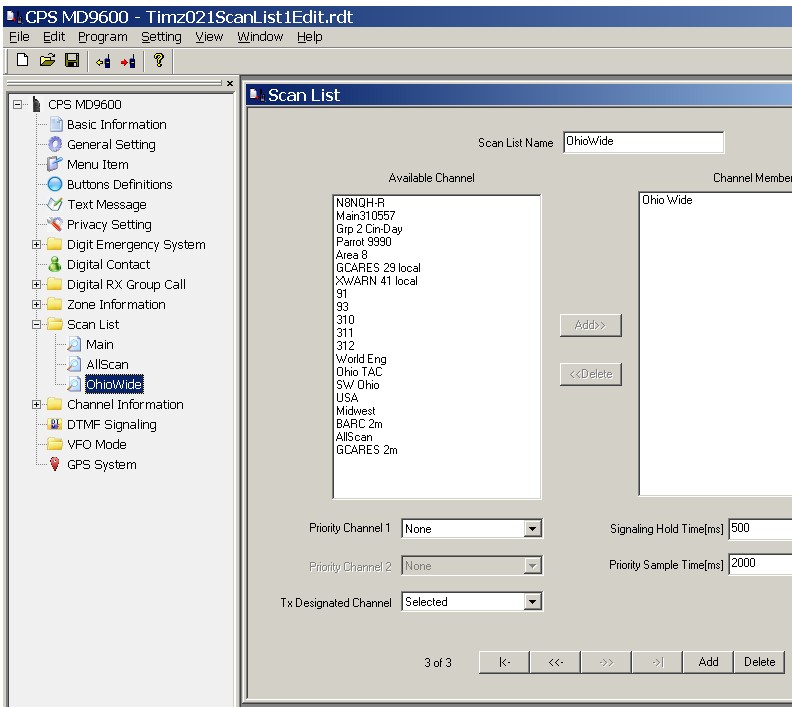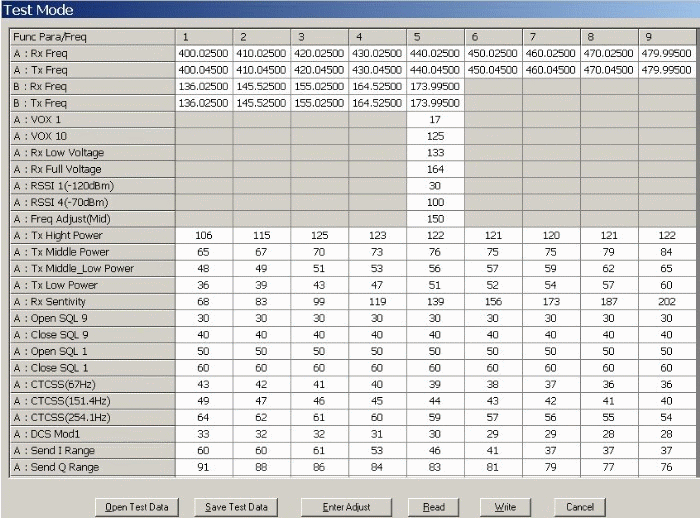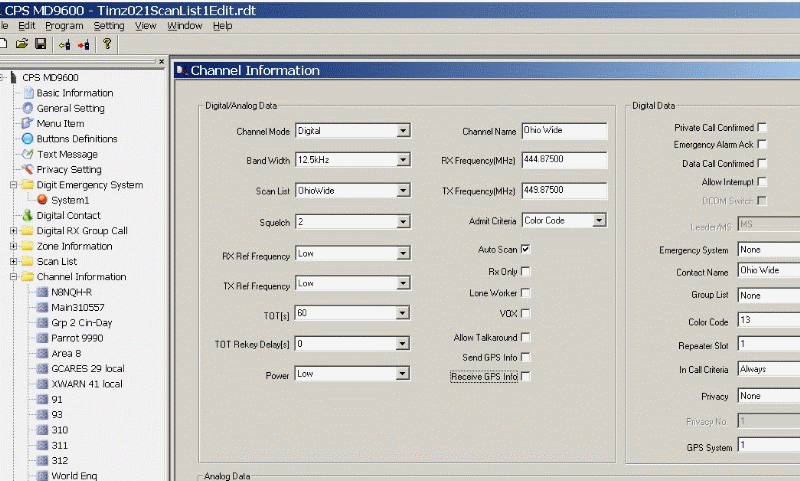Timz DMR Repeater
return to DMR page , return to Radios page , helpful tools
Hints & Tips
1. Backup the radios alignment settings:
This can be (and should be) done on a brand new radio that hasn't been given a new codeplug yet...If radio is brand new...read the factories radios programming into the software and save it as "default" or "factory" (or whatever name has the proper meaning to you). You never know when the situation may arise to where you need to give this radio it's original factory codeplug.
Then from any program screen - press "Ctrl t" (press & hold your keyboards "Ctrl" button... then press the "t" keyboard key, then release). You should see a screen like this:
this is your radios alignment data (using "soft-pots"). You should save this test data; if your radio ever hiccups and ScRaMbLeS these values, you will be glad you saved them.
"SaveTestData" (give it a name like "AlignData"... or whatever has meaning to you), then once saved... click on "Cancel".
2. Operate as a single VFO - automatically...
even if you have both VFO's programmed with channels & Zones.
Tired of seeing "Unprogrammed" shown on the bottom VFO?
or...
Tired of hearing "holes" cut into recepton when the radio chooses to listen to the bottom VFO for a few seconds?
You can have channels in VFO A & B as well, but escape the hassles. This is done on a channel-by-channel basis.
A. Create a Scan List that only has one channel in it:

B. Go into that same channel screen, and assign it to that Scan list, and check "Auto Scan"
Every time you dial/select that channel, the other VFO will blank out.
3. This is a dual band radio, but
it's not a "twin band". You only use one at a time; even though both are displayed. You can have different DMR zones selected for each band, but it will receive only one at a time. When receiving on one band... the other seems to be muted.
You can have both 2m & 440 combined in one zone though, and A&D channels as well. The top/bottom (A & B ) VFO's are not restricted to a single band... you can have both bands in a zone. Same goes for the bottom VFO; can have mixed A&D, and both 2m and 440 channels. This is all about a "Rev 3" version radio.
See below: "to disable one of the two bands "...
4. Disable one band/VFO
to disable one of the two bands (A or B)... press and hold the ENT button. A speaker icon with "X" will appear on the other band, then release button
It is now disabled. To disable B (bottom band), have the active band as A, then press & hold the ENT until you see the above icon appear on B.... release. Repeat to re-enable.
5. To place radio into VFO mode:
radio needs to be in "Freq" display mode first (in this mode, the frequency of the memory channel is shown instead of the alias name). To switch to this mode you can make the change in the programming file, or by navigating the MENU via the radios front panel (using the ENT and up/dwn arrow buttons).Press and release the ENT button...Utilities
Radio Setting
Mode
MR modeOnce in the freq mode: select which band you want to change to VFO operation (A or B)... then press & hold the BAND button until the VFO mode is shown... release. Repeat to go back into the memory channel mode.
Either dial a frequency... or enter in a freq via the handmic keypad.
6. to have the radio power up with a unique text screen
(with your call sign and DMR ID... or whatever you want it to display)... in the program software - navigate to the General Setting screen, then near the bottom is a box called "Intro Screen". Select "Char string", then type in two lines of power-on text in the two fields below it.
7. Mic Jack pinout
Return to the MD-9600 Codeplug page
Timz
DMR Repeater click HERE to see the registration & activity for the N8NQH DMR repeater on Brandmeister
click HERE for handy DMR Toolz to make your DMR experience better
Click HERE to visit the ARES Ohio Section DMR Radio page
click HERE to read info on basic DMR repeater operational procedures
click HERE for radio codeplugs already configured
click HERE for indepth details about the groups
Contact Repeater Administrators


